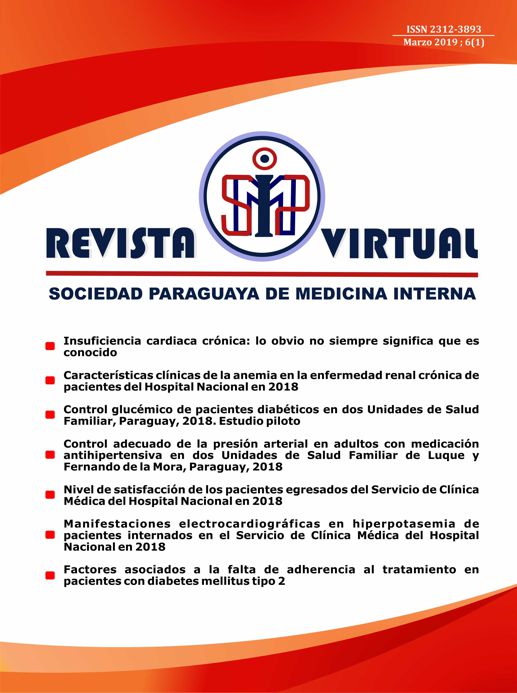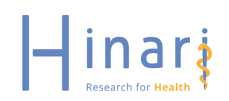Recomendaciones latinoamericanas para el manejo de la hipertensión arterial en adultos (RELAHTA 2)
Resumen
Se presenta la segunda parte de las recomendaciones latinoamericanas para el manejo de la Hipertensión Arterial (HTA) en adultos. En una primera fase se han descripto los aspectos más relevantes de la epidemiología, aspectos fisiopatológicos, cómo hacer diagnóstico, pautas terapéuticas, urgencias y emergencias hipertensivas, poblaciones especiales, hipertensión refractaria y la aplicación de las guías en la vida real. En esta segunda parte, se emiten recomendaciones respondiendo a preguntas específicas para prevención primaria, secundaria, terciaria y cuaternaria. En general pocas recomendaciones al respecto del manejo de la hipertensión arterial surgen desde la clínica médica/ medicina interna, a pesar de dos situaciones: la mayoría de los pacientes con hipertensión arterial son evaluados y manejados por los clínicos, y la clínica médica es la especialidad que permite la mirada holística e integrada de los problemas de salud del adulto, permitiendo agregar el enfoque biográfico al biológico, comprender e interpretar no solo el problema de salud sino sus causas y consecuencias (que muchas veces suelen corresponder a diferentes parénquimas, lo cual en el modelo fragmentado haría transitar al paciente por distintas especialidades). El bajo porcentaje de pacientes hipertensos controlados obliga a todos los profesionales involucrados en el manejo de los mismos a optimizar recursos y detectar problemas que se asocien a un control deficitario como la sub utilización del tratamiento farmacológico, baja tasa de pacientes tratados con estrategia combinada (la mayoría de los pacientes actualmente recibe monoterapia), falta de prescripción adecuada de los cambios en el estilo de vida, baja adherencia terapéutica e inercia clínica. En la presente publicación se presentan recomendaciones efectuadas por especialistas en clínica médica / medicina interna para el manejo de la hipertensión arterial en adultos, respondiendo preguntas de prevención primaria, secundaria, terciaria, y cuaternaria.
Citas
2. Zhou B, Bentham J, Di Cesare M, Bixby H, Danaei G, Cowan MJ, et al. Worldwide trends in blood pressure from 1975 to 2015: a pooled analysis of 1479 population-based measurement studies with 19·1 million participants. Lancet. 2017;389(10064):37–55.
3. Abuabara Turbay Y, Andrade Belgeri RE, Arbo Oze de Morvil GA, Arias C, Cámera LA, Carballo Zárate V, et al. Recomendaciones Latinoamericanas para el manejo de la hipertensión arterial en adultos (Relahta) Parte 1. Rev urug med interna. 2018; 3: 38-93.
4. Delucchi AM, Majul CR, Vicario A, Cerezo GH, Fábregues G, et al. Registro nacional de hipertensión arterial. Características epidemiológicas de la hipertensión arterial en Argentina. Estudio RENATA 2. Rev Argent Cardiol 2017; 85:354-60.
5. Olsen MH, Angell SY, Asma S, Boutouyrie P, Burguer D, Chirinos JA, et al. A call to action and a lifecourse strategy to address the global burden of raised blood pressure on current and future generations: The Lancet Commission on hypertension. Lancet. 2016; 388(10060):2665–712.
6. Mills KT, Bundy JD, Kelly TN, Reed JE, Kearney PM, Reynolds K, et al. Global disparities of hypertension prevalence and control: A systematic analysis of population-based studies from 90 countries. Circulation. 2016;134(6):441–50.
7. Sabio R, Valdez P, Barile ME, Brosio DA, Caliani LJ, Cámera LA, et al. Recomendaciones para el manejo de la Hipertension Arterial de la Sociedad Argentina de Medicina. Rev Arg Med. 2018; 86 (supl 2):1-54.
8. Thomopoulos C, Parati G, Zanchetti A. Effects of blood pressure lowering on outcome incidence in hypertension. 1. Overview, meta-analyses, and metaregression analyses of randomized trials. J Hypertens 2014; 32(12):2285–95.
9. Tsai WC, Wu HY, Peng YS, Yang JY, Chen HY, Chiu YL, et al. Association of intensive blood pressure control and kidney disease progression in nondiabetic patients with chronic kidney disease: a systematic review and meta-analysis. JAMA Intern Med 2017; 177(6):792–9.
10. William B, Mancia G, Spiering W, Agabiti Rosei E, Azizi M, Burnier M, et al. 2018 ESC/ESH Guidelines for the management of arterial hypertension. Eur Heart J. 2018; 39(33): 3021-3104.
11. Sociedad Argentina de Cardiología, Federación Argentina de Cardiología, Sociedad Argentina de Hipertensión Arterial. Consenso argentino de hipertensión arterial. Rev Argent Cardiol. 2018; 86(Supl.2):1-53.
12. Whelton PK, Carey RM, Aronow WS, Casey DE Jr, Collins KJ, Dennison Himmelfarb C, et al. 2017 ACC/AHA/AAPA/ABC/ACPM/AGS/APhA/ASH/ASPC/NMA/PCNA guideline for the prevention, detection, evaluation, and management of high blood pressure in adults: A report of the American College of Cardiology/American Heart Association Task Force on Clinical Practice Guidelines. J Am Coll Cardiol 2018;71(19): e127–e248.
13. Barochiner J, Bendersky M, Cuffaro P, Majul C, Marin M, Nannini D, coordinadores, et al. Toma de posición de la Sociedad Argentina de Hipertension Arterial: Medición de la presión arterial fuera del consultorio MAPA-MDPA /Internet/: Sociedad Argentina de Hipertension Arterial; 2015. /citado 27 set 2018/ Disponible en: http://www.saha.org.ar/pdf/formacion/TomaDePosicion-Libro2015.pdf
14. Selvaraj S, Steg PG, Elbez Y, Sorbets E, Feldman LJ, Eagle KA, et al. Pulse pressure and risk for cardiovascular events in patients with atherothrombosis: from the REACH Registry. J Am Coll Cardiol. 2016; 67(4):392–403.
15. Redon J, Pascual JM. Development of microalbuminuria in essential hypertension. Curr Hypertens Rep. 2006; 8(2):171-7.
16. Ninomiya T, Perkovic V, de Galan BE, Zoungas S, Pillai A, Jardine M, et al. Albuminuria and kidney function independently predict cardiovascular and renal outcomes in diabetes. J Am Soc Nephrol. 2009; 20(8):1813–21.
17. Bacharova L, Schocken D, Estes EH, Strauss D. The role of ECG in the diagnosis of left ventricular hypertrophy. Curr Cardiol Rev. 2014; 10(3):257–61.
18. Lehtonen AO, Puukka P, Varis J, Porthan K, Tikkanen JT, Nieminen MS, et al. Prevalence and prognosis of ECG abnormalities in normotensive and hypertensive individuals. J Hypertens. 2016; 34(5):959–66.
19. Bang CN, Devereux RM, Okin PM. Regression of electrocardiographic left ventricular hypertrophy or strain is associated with lower incidence of cardiovascular morbidity and mortality in hypertensive patients independent of blood pressure reduction - a LIFE review. J Electrocardiol. 2014; 47(5):630-5.
20. Bombelli M, Facchetti R, Cuspidi C, Villa P, Dozio D, Brambilla G, et al. Prognostic significance of left atrial enlargement in a general population: results of the PAMELA study. Hypertension 2014; 64(6):1205–11.
21. de Simone G, Izzo R, Chinali M, De Marco M, Casalnuovo G, Rozza F, et al Does information on systolic and diastolic function improve prediction of a cardiovascular event by left ventricular hypertrophy in arterial hypertension? Hypertension 2010; 56(1):99–104.
22. Devereux RB, Wachtell K, Gerdts E, Boman K, Nieminen MS, Papademetriou V, et al. Prognostic significance of left ventricular mass change during treatment of hypertension. JAMA 2004; 292(19):2350–6.
23. De Simone G, Izzo R, Aurigemma GP, De Marco M, Rozza F, Trimarco V, et al. Cardiovascular risk in relation to a new classification of hypertensive left ventricular geometric abnormalities. J Hypertens. 2015; 33(4):745–54.
24. Douglas PS, García MJ, Haines DE, Lai WW, Manning WJ, Patel AR, et al. ACCF/ASE/AHA/ASNC/HFSA/HRS/SCAI/SCCM/SCCT/SCMR 2011 appropriate use criteria for echocardiography. J Am Soc Echocardiogr. 2011; 24:229-67.
25. Perrone Filardi P, Coca A, Galderisi M, Paolillo S, Alpendurada F, de Simone G, et al. Non-invasive cardiovascular imaging for evaluating subclinical target organ damage in hypertensive patients: a consensus article from the European Association of Cardiovascular Imaging, the European Society of Cardiology Council on Hypertension and the European Society of Hypertension. J Hypertens 2017; 35(9):1727–41.
26. Marwick TH, Gillebert TC, Aurigemma G, Chirinos J, Derumeaux G, Galderisi M, et al. Recommendations on the use of echocardiography in adult hypertension: a report from the European Association of Cardiovascular Imaging (EACVI) and the American Society of Echocardiography (ASE). Eur Heart J Cardiovasc Imaging 2015; 16(6):577–605.
27. Bertomeu V, Morillas P, Gonzalez-Juanatey JR, Quiles J, Guindo J, Soria F, et al. Prevalence and prognostic influence of peripheral arterial disease in patients >or=40 years old admitted into hospital following an acute coronary event. Eur J Vasc Endovasc Surg 2008; 36(2):189–96.
28. Hirsch AT, Haskal ZJ, Hertzer NR, Bakal CW, Creager MA, Halperin JL, et al. ACC/AHA 2005 guidelines for the management of patients with peripheral arterial disease (lower extremity, renal, mesenteric, and abdominal aortic): executive summary a collaborative report from the American Association for Vascular Surgery/Society for Vascular Surgery, Society for Cardiovascular Angiography and Interventions, Society for Vascular Medicine and Biology, Society of Interventional Radiology, and the ACC/AHA Task Force on Practice Guidelines (Writing Committee to Develop Guidelines for the Management of Patients With Peripheral Arterial Disease) endorsed by the American Association of Cardiovascular and Pulmonary Rehabilitation; National Heart, Lung, and Blood Institute; Society for Vascular Nursing; TransAtlantic Inter-Society Consensus; and Vascular Disease Foundation. J Am Coll Cardiol. 2006; 47(6):1239-312.
29. Feringa HH, Bax JJ, Van Waning VH, Boersma E, Elhendy A, Schouten O, et al. The long-term prognostic value of the resting and postexercise ankle-brachial index. Arch Intern Med. 2006; 166(5):529–35.
30. Nambi V, Chambless L, Folsom AR, He M, Hu Y, Mosley T, et al. Carotid intima-media thickness and presence or absence of plaque improves prediction of coronary heart disease risk: the ARIC (Atherosclerosis Risk In Communities) study. J Am Coll Cardiol. 2010; 55(15):1600–7.
31. Sehestedt T, Jeppesen J, Hansen TW, Wachtell K, Ibsen H, Torp-Pedersen C, Hildebrandt P, Olsen MH. Risk prediction is improved by adding markers of subclinical organ damage to SCORE. Eur Heart J. 2010; 31(7):883–91.
32. Van Bortel LM, Laurent S, Boutouyrie P, Chowienczyk P, Cruickshank JK, De Backer T, et al. Expert consensus document on the measurement of aortic stiffness in daily practice using carotid-femoral pulse wave velocity. J Hypertens. 2012; 30(3):445–8.
33. Ben-Shlomo Y, Spears M, Boustred C, May M, Anderson SG, Benjamin EJ, et al. Aortic pulse wave velocity improves cardiovascular event prediction: an individual participant meta-analysis of prospective observational data from 17,635 subjects. J Am Coll Cardiol. 2014; 63(7):636–46.
34. O’Brien E, Waeber B, Parati G, Staessen J, Myers MG. Blood pressure measuring devices: recommendations of the European Society of Hypertension. BMJ. 2001; 322(7285):531–6.
35. Pickering T. Recommendations for the use of home (self) and ambulatory blood pressure monitoring. Am J Hypertens. 1996; 9(1):1-11.
36. Mancia G. Clinical significance of white-coat hypertension. J Hypertens. 2016; 34(4):623–6.
37. Mancia G. White-coat hypertension: growing evidence in favour of its adverse prognostic significance. J Hypertens. 2017; 35(4):710–2.
38. Asayama K, Li Y, Franklin SS, Thijs L, O’Brien E, Staessen JA. Cardiovascular risk associated with white-coat hypertension: con side of the argument. Hypertension. 2017; 70(4):676–82
39. Pierdomenico SD, Cuccurullo F. Prognostic value of white-coat and masked hypertension diagnosed by ambulatory monitoring in initially untreated subjects: an updated meta analysis. Am J Hypertens. 2011; 24(1):52–8.
40. Statement on ambulatory blood pressure monitoring by the German Hypertension League. Blood pressure measurement section of the Deutsche Liga zur Bekämpfung des hohen Blutdruckes e. V. (German Hypertension League). J Hum Hypertens. 1995; 9(9):777-9.
41. Sega R, Trocino G, Lanzarotti A, Carugo S, Cesana G, Schiavina R, et al. Alterations of cardiac structure in patients with isolated office, ambulatory, or home hypertension: Data from the general population (Pressione Arteriose Monitorate E Loro Associazioni [PAMELA] Study). Circulation. 2001; 104(12):1385-92.
42. Briasoulis A, Androulakis E, Palla M, Papageorgiou N, Tousoulis D. White-coat hypertension and cardiovascular events: A meta-analysis. J Hypertens. 2016; 34(4):593–9.
43. Huang Y, Huang W, Mai W, Cai X, An D, Liu Z, et al. White-coat hypertension is a risk factor for cardiovascular diseases and total mortality. J Hypertens. 2017; 35(4):677–688
44. Bobrie G, Clerson P, Menard J, Postel-Vinay N, Chatellier G, Plouin PF. Masked hypertension: a systematic review. Journal of Hypertension. 2008; 26(9):1715–25.
45. Pickering TG, Gerin W, Schwartz JE, Spruill TM, Davidson KW, et al. Franz volhard lecture: Should doctors still measure blood pressure? The missing patients with masked hypertension. J Hypertens. 2008; 26(12):2259–67.
46. Hanninen MR, Niiranena TJ, Puukkaa PJ, Aino K. Mattila AK, Jula AM. Determinants of masked hypertension in the general population: the Finn-Home study. J Hypertens. 2011; 29(10):1880–8.
47. Banegas JR, Ruilope LM, de la Sierra A, Vinyoles E, Gorostidi M, de la Cruz JJ, et al. Relationship between clinic and ambulatory blood-pressure measurements and mortality. N Engl J Med. 2018; 378(16):1509–20.
48. Blood pressure-lowering treatment based on cardiovascular risk: a meta-analysis of individual patient data. Lancet. 2014; 384(9943): 591–8.
49. Sehestedt T, Jeppesen J, Hansen TW, Wachtell K, Ibsen H, Torp Pedersen C, et al. Risk prediction is improved by adding markers of subclinical organ damage to SCORE. Eur Heart. J 2010; 31(7):883–91.
50. Piepoli MF, Hoes AW, Agewall S, Albus C, Brotons C, Catapano AL, et al. 2016 European guidelines on cardiovascular disease prevention in clinical practice: The sixth joint task force of the European Society of Cardiology and other societies on cardiovascular disease prevention in clinical practice (constituted by representatives of 10 societies and by invited experts) Developed with the special contribution of the European Association for Cardiovascular Prevention & Rehabilitation (EACPR). Eur Heart J. 2016; 37(29): 2315–81.
51. Siontis GC, Tzoulaki I, Siontis KC, Ioannidis JP. Comparisons of established risk prediction models for cardiovascular disease: systematic review. BMJ. 2012; 344: e3318.
52. Mancia G, Fagard R, Narkiewicz K, Redón J, Zanchetti A, Böhm M, et al. 2013 ESH/ESC guidelines for the management of arterial hypertension: the Task force for the management of arterial hypertension of the European Society of Hypertension (ESH) and of the European Society of Cardiology (ESC). Eur Heart J. 2013; 3(28)4: 2159-219.
53. World Health Organization. Prevention of cardiovascular disease: guidelines for assessment and management of cardiovascular risk /Internet/. Geneva: WHO; 2007 /cited December 20, 2018./ Available from: https://www.who.int/cardiovascular_diseases/guidelines/Full%20text.pdf
54. Kotseva K, Wood D, De Bacquer D, De Backer G, Rydén L, Jennings C, et al. EUROASPIRE IV: A European Society of Cardiology survey on the lifestyle, risk factor and therapeutic management of coronary patients from 24 European countries. Eur J Prev Cardiol. 2016;23(6): 636–48.
55. Huffman MD, Capewell S, Ning H, Shay CM, Ford ES, Lloyd-Jones DM. Cardiovascular health behavior and health factor changes (1988–2008) and projections to 2020: results from the National Health and Nutrion Examination Surveys. Circulation. 2012;125(21): 2595–602.
56. Miller V, Yusuf S, Chow CK, Dehghan M, Corsi DJ, Lock K, et al. Availability, affordability, and consumption of fruits and vegetables in 18 countries across income levels: findings from the Prospective Urban Rural Epidemiology (PURE) study. Lancet Glob Health. 2016; 4(10): e695-703. doi. org/10.1016/S2214-109X(16)30186-3.
57. Argentina. Ministerio de Salud de la Nación, Instituto Nacional de Estadística y Censos. Tercera encuesta nacional de factores de riesgo para enfermedades crónicas no transmisibles /Internet/. Buenos Aires: El Ministerio; 2015. /citado 20 diciembre de 2018/. Disponible en: http://www.msal.gob.ar/images/stories/bes/graficos/0000000544cnt-2015_09_04_encuesta_nacional_factores_riesgo.pdf
58. Lonn EM, Bosch J, Lopez-Jaramillo P, Zhu J, Liu L, Pais P, et al. Blood-pressure lowering in intermediate-risk persons without cardiovascular disease. N Eng J Med. 2016; 374(21):2009–20.
59. Brunström M, Carlberg B. Association of Blood Pressure Lowering with mortality and cardiovascular disease across blood pressure levels: A systematic review and meta-analysis. JAMA Intern Med. 2018; 178(1):28-36.
60. Morales Salinas A, Coca A, Olsen MH, Sanchez RA, Sebba-Barroso WK, Kones R, et al. Clinical perspective on antihypertensive drug treatment in adults with grade 1 hypertension and low-to-moderate cardiovascular risk: an international expert consultation. Curr Probl Cardiol. 2017; 42(7):198–225.
61. Wald DS, Law M, Morris JK, Bestwick JP, Wald NJ. Combination therapy versus monotherapy in reducing blood pressure: meta-analysis on 11,000 participants from 42 trials. Am J Med. 2009; 122(3):290–300.
62. MacDonald TM, Williams B, Webb DJ, Morant S, Caulfield M, Cruickshank JK, et al. Combination therapy is superior to sequential monotherapy for the initial treatment of hypertension: a double-blind randomized controlled trial. J Am Heart Assoc. 2017;6(11)pii: e006986.
63. Egan BM, Bandyopadhyay D, Shaftman SR, Wagner CS, Zhao Y, Yu-Isenberg KS. Initial monotherapy and combination therapy and hypertension control the first year. Hypertension. 2012; 59(6):1124–31.
64. Dahlof B, Sever PS, Poulter NR, Wedel H, Beevers DG, Caulfield M, et al. Prevention of cardiovascular events with an antihypertensive regimen of amlodipine adding perindopril as required versus atenolol adding bendroflumethiazide as required, in the Anglo-Scandinavian Cardiac Outcomes Trial-Blood Pressure Lowering Arm (ASCOT-BPLA): a multicentre randomised controlled trial. Lancet. 2005; 366(9489):895–906.
65. Jamerson K, Weber MA, Bakris GL, Dahlof B, Pitt B, Shi V, et al. Benazepril plus amlodipine or hydrochlorothiazide for hypertension in high-risk patients. N Engl J Med. 2008; 359(23):2417–28.
66. Matsuzaki M, Ogihara T, Umemoto S, Rakugi H, Matsuoka H, Shimada K, et al. Prevention of cardiovascular events with calcium channel blocker-based combination therapies in patients with hypertension: a randomized controlled trial. J Hypertens. 2011; 29(8):1649–59.
67. Thomopoulos C, Parati G, Zanchetti A. Effects of blood pressure lowering on outcome incidence in hypertension: 4. Effects of various classes of antihypertensive drugs–overview and meta-analyses. J Hypertens. 2015; 33(2):195–211.
68. Gradman AH, Basile JN, Carter BL, Bakris GL; American Society of Hypertension Writing Group. Combination therapy in hypertension. J Am Soc Hypertens 2010;4(1):42-50.
69. Gupta AK, Arshad S, Poulter NR. Compliance, safety, and effectiveness of fixed-dose combinations of antihypertensive agents: a meta-analysis. Hypertension 2010; 55(2):399–407.
70. Corrao G, Parodi A, Zambon A, Heiman F, Filippi A, Cricelli C, Merlino L, Mancia G. Reduced discontinuation of antihypertensive treatment by two-drug combination as first step. Evidence from daily life practice. J Hypertens 2010; 28(7):1584–90
71. Fried LF, Emanuele N, Zhang JH, Brophy M, Conner TA, Duckworth W, et al. Combined angiotensin inhibition for the treatment of diabetic nephropathy. N Engl J Med. 2013; 369(20):1892–903.
72. ONTARGET Investigators, Yusuf S, Teo KK, Pogue J, Dyal L, Copland I, Schumacher H, et al. Telmisartan, ramipril, or both in patients at high risk for vascular events. N Engl J Med. 2008;358(15):1547–59.
73. Kizilirmak P, Berktas M, Uresin Y, Yildiz OB. The efficacy and safety of triple vs dual combination of angiotensin II receptor blocker and calcium channel blocker and diuretic: a systematic review and meta-analysis. J Clin Hypertens (Greenwich). 2013; 15(3):193-200.
74. Gorostidi M, de la Sierra A. Combination therapy in hypertension. Adv Ther. 2013; 30(4):320-36.
75. Baigent C, Blackwell L, Emberson J, Holland LE, Reith C, Bhala N, et al. Efficacy and safety of more intensive lowering of LDL cholesterol: a meta-analysis of data from 170,000 participants in 26 randomised trials. Lancet. 2010; 376(9753):1670-81.
76. Catapano AL, Graham I, De Backer G, Wiklund O, Chapman MJ, Drexel H, et al. 2016 ESC/EAS guidelines for the management of dyslipidaemias. Eur Heart J. 2016; 37(39):2999–3058.
77. Fulcher J, O’Connell R, Voysey M, Emberson J, Blackwell L, Mihaylova B, et al. Efficacy and safety of LDL-lowering therapy among men and women: meta-analysis of individual data from 174,000 participants in 27 randomised trials. Lancet 2015; 385(9976):1397–405.
78. Yusuf S, Lonn E, Pais P, Bosch J, Lopez-Jaramillo P, Zhu J, et al. Blood-pressure and cholesterol lowering in persons without cardiovascular disease. N Engl J Med. 2016;374(21): 2032–43.
79. Lip GYH, Felmeden DC, Dwivedi G. Antiplatelet agents and anticoagulants for hypertension. Cochrane Database Syst Rev. 2011; (12):CD003186.
80. Kronish IM, Woodward M, Sergie Z, Ogedegbe G, Falzon L, Mann DM. Meta-analysis: impact of drug class on adherence to antihypertensives. Circulation 2011;123(15):1611-1621
81. Tiffe T, Wagner M, Rucker V, Morbach C, Gelbrich G, Stork S, Heuschmann PU. Control of cardiovascular risk factors and its determinants in the general population- findings from the STAAB cohort study. BMC Cardiovasc Disord. 2017; 17(1):276.
82. Ingaramo RA, Vita N, Bendersky M, Arnolt M, Bellido C, Piskorz D, et al. Estudio Nacional Sobre Adherencia al Tratamiento (ENSAT). Rev Fed Arg Cardiol. 2005; 34: 104-11.
83. Zilberman J, cordinación general. Toma de posición sobre adherencia al tratamiento antihipertensivo /Internet/: Sociedad Argentina de Hipertensión Arterial; 2016. /citado 20 de diciembre de 2018/. Disponible en: http://www.saha.org.ar/bundles/sitefrontend/files/formation/tomadesposicion-ad-2016.pdf
84. Abegaz TM, Shehab A, Gebreyohannes EA, Bhagavathula AS, Elnour AA. Nonadherence to antihypertensive drugs: A systematic review and meta-analysis. Medicine (Baltimore) 2017; 96(4): e5641.
85. Panjabi S, Lacey M, Bancroft T, Cao F. Treatment adherence, clinical outcomes, and economics of triple-drug therapy in hypertensive patients. J Am Soc Hypertens. 2013; 7(1):46-60.
86. Corrao G, Parodi A, Nicotra F, Zambon A, Merlino L, Cesana G, Mancia G. Better compliance to antihypertensive medications reduces cardiovascular risk. J Hypertens. 2011; 29(3): 610-8.
87. Myat A, Redwood SR, Qureshi AC, Spertus JA, Williams B. Resistant hypertension. BMJ. 2012; 345:e7473.
88. de la Sierra A, Banegas JR, Segura J, Gorostidi M, Ruilope LM. Ambulatory blood pressure monitoring and development of cardiovascular events in high-risk patients included in the Spanish ABPM registry: the CARDIORISC Event study. J Hypertens. 2012; 30(4):713–9.
89. Zannad F. Aldosterone antagonist therapy in resistant hypertension. J Hypertens. 2007; 25(4):747–50.
90. James PA, Oparil S, Carter BL, Cushman WC, Dennison-Himmelfarb C, Handler J, et al. 2014 Evidence-based guideline for the management of high blood pressure in adults: report from the panel members appointed to the Eighth Joint National Committee (JNC 8). JAMA 2014; 311(5):507-20.
91. Yano Y, Lloyd-Jones DM. Isolated systolic hypertension in young and middle-aged adults. Curr Hypertens Rep. 2016; 18(11):78.
92. Mallion JM, Hamici L, Chatellier G, Lang T, Plouin PF, De Gaudemaris R.. Isolated systolic hypertension: data on a cohort of young subjets from a French working population(IHPAF). J Human Hypertens. 2003;17(2): 93-100.
93. Beckett NS, Peters R, Fletcher AE, Staessen JA, Liu L, Dumitrascu D, et al. Treatment of hypertension in patients 80 years of age or older. N Engl J Med. 2008; 358(18):1887–98.
94. SHEP Cooperative Research Group. Prevention of stroke by antihypertensive drug treatment in older persons with isolated systolic hypertension. Final results of the Systolic Hypertension in the Elderly Program (SHEP). JAMA 1991; 265(24):3255–64.
95. Pepine CJ, Handberg EM, Cooper-DeHoff RM, Marks RG, Kowey P, Messerli FH, et al. A calcium antagonist vs a non-calcium antagonist hypertension treatment strategy for patients with coronary artery disease. The International Verapamil-Trandolapril Study (INVEST): a randomized controlled trial. JAMA 2003; 290(21):2805–16.
96. Briasoulis A, Agarwal V, Tousoulis D, Stefanadis C. Effects of antihypertensive treatment in patients over 65 years of age: a meta-analysis of randomised controlled studies. Heart. 2014; 100(4): 100:317–23.
97. Jamerson K, Weber MA, Bakris GL, Dahlöf B, Pitt B, Shi V, et al. Benazepril plus amlodipine or hydrochlorothiazide for hypertension in high-risk patients. N Engl J Med. 2008; 359(23):2417-28.
98. Sibai BM. Diagnosis and management of gestational hypertension and preeclampsia. Obstet Gynecol. 2003; 102(1):181-92.
99. Berg CJ, MacKay AP, Qin C, Callaghan WM. Overview of maternal morbidity during hospitalization for labor and delivery in the United States 1993-1997 and 2001-2005. Obstet Gynecol. 2009; 113(5): 1075-81.
100. Sibai B, Lecarpentier E, Kayem G, Haddad B, Tsatsaris V, Goffinet F. Adverse maternal and perinatal outcomes in women with chronic hypertension: a retrospective study of 362 patients. Am J Obstet Gynecol. 2011; 204(Supp 1):S294.
101. American College of Obstetricians and Gynecologists, Task Force on Hypertension in Pregnancy. Hypertension in pregnancy. Report of the American College of Obstetricians and Gynecologists’ Task Force on Hypertension in Pregnancy. Obstet Gynecol. 2013; 122(5):1122-31.
102. Magee LA, Pels A, Helewa M, Rey E, von Dadelszen P. Diagnosis, evaluation, and management of the hypertensive disorders of pregnancy: executive summary. J Obstet Gynaecol Can. 2014; 36(5):416-41.
103. National Institute for Health and Care Excellence. Hypertension in pregnancy: diagnosis and management /Internet/. London: National Institute for Health and Clinical Excellence; 2011 /cited 2018 June 28/. (Clinical guideline; no. 107). Available from: https://www.nice.org.uk/guidance/cg107
104. Regitz-Zagrosek V, Blomstrom Lundqvist C, Borghi C, Cifkova R, Ferreira R, Foidart JM, et al. ESC guidelines on the management of cardiovascular diseases during pregnancy. Eur Heart J. 2011; 32:3147-97.
105. Abalos E, Duley L, Steyn DW. Antihypertensive drug therapy for mild to moderate hypertension during pregnancy. Cochrane Database Syst Rev. 2014. (2):CD002252.
106. Magee LA, von Dadelszen P, Rey E, Ross S, Asztalos E, Murphy KE, et al. Less-tight versus tight control of hypertension in pregnancy. N Engl J Med. 2015; 372(5):407-17.
107. Potter JF, Robinson TG, Ford GA, Mistri A, James M, Chernova J, Jagger C. Controlling hypertensión and hypotension immediately post-stroke (CHHIPS): a randomised, placebo –controlled, double-blind pilot trial. Lancet Neurol. 2009; 8(1):48-56.
108. Katsanos AH, Filippatou A, Manios E, Deftereos S, Parissis J, Frogoudaki A, et al. Blood pressure reduction and secondary stroke prevention a systematic review and metaregression analysis of randomized clinical trials. Hypertension. 2017; 69(1):171-9.
109. Liu L, Wang Z, Gong L, Zhang Y, Thijs L, Staessen JA, Wang J. Blood pressure reduction for the secondary prevention of stroke: a Chinese trial and a systematic review of the literature. Hypertens Res. 2009; 32(11):1032-40.
110. PROGRESS Collaborative Group. Randomised trial of a perindopril-based blood-pressure-lowering regimen among 6,105 individuals with previous stroke or transient ischaemic attack. Lancet. 2001; 358(9287):1033–41.
111. Pigretti S, Alet M, Mamani C, Aguilar M, Alvarez HJ, Andrade MG, et al. Consenso argentino intersociedades para el manejo del accidente cerebrovascular isquémico 2018. Medicina Buenos Aires 2019 (en prensa). https://www.medicinabuenosaires.com/
112. Yusuf S, Hawken S, Ounpuu S, Dans T, Avezum A, Lanas F, et al. Effect of potentially modifiable risk factors associated with myocardial infarction in 52 countries (the INTERHEART study): case-control study. Lancet. 2004; 364(9438):937–52.
113. Turnbull F. Effects of different blood-pressure-lowering regimens on major cardiovascular events: results of prospectively-designed overviews of randomised trials. Lancet. 2003;362(9395):1527–35.
114. Bangalore S, Messerli FH, Wun ChCh, Zuckerman AL, DeMicco D, Kostis JB, et al. J-Curve revisited: an analysis of the Treating to New Targets (TNT) Trial. J Am Coll Cardiol. 2009;53: A217.
115. Yusuf S, Sleight P, Pogue J, Bosch J, Davies R, Dagenais G. Effects of an angiotensin-converting-enzyme inhibitor, ramipril, on cardiovascular events in high-risk patients. N Engl J Med. 2000; 342(3):145–53.
116. Malhotra R, Nguyen HA, Benavente O, Mete M, Howard BV, Mant J, et al. Association between more intensive vs less intensive blood pressure lowering and risk of mortality in chronic kidney disease stages 3 to 5: a systematic review and meta-analysis. JAMA Intern Med. 2017; 177(10):1498–505.
117. Brunstrom M, Carlberg B. Effect of antihypertensive treatment at different blood pressure levels in patients with diabetes mellitus: systematic review and meta-analyses. BMJ. 2016; 352:i717.
118. Thomopoulos C, Parati G, Zanchetti A. Effects of blood-pressure-lowering treatment on outcome incidence in hypertension: 10 - Should blood pressure management differ in hypertensive patients with and without diabetes mellitus? Overview and meta-analyses of randomized trials. J Hypertens. 2017; 35(5):922–44.
119. Bakris GL, Sarafidis PA, Weir MR, Dahlof B, Pitt B, Jamerson K, et al. Renal outcomes with different fixed-dose combination therapies in patients with hypertension at high risk for cardiovascular events (ACCOMPLISH): a prespecified secondary analysis of a randomised controlled trial. Lancet. 2010; 375(9721):1173–81.
120. UK Prospective Diabetes Study Group (UKPDS). Tight blood pressure control and risk of macrovascular and microvascular complications in type 2 diabetes: UKPDS 38. BMJ. 1998; 317:703-13.
121. Rimoldi SF, Scherrer U, Messerli FH. Secondary arterial hypertension: when, who, and how to screen? Eur Heart J. 2014; 35(19):1425-54.

















